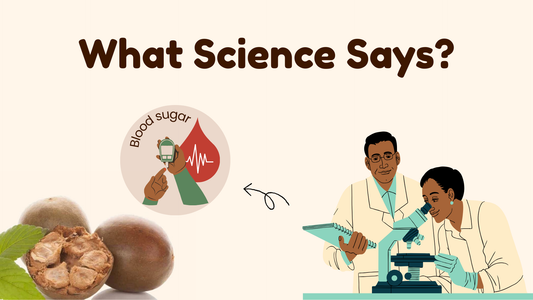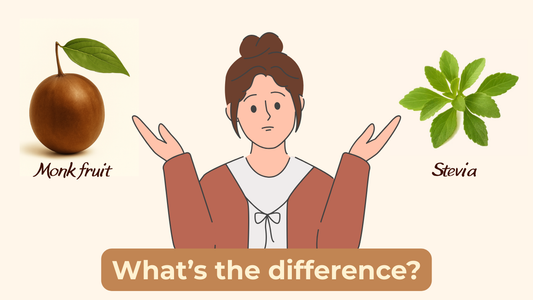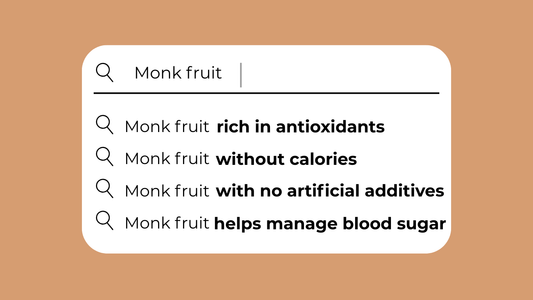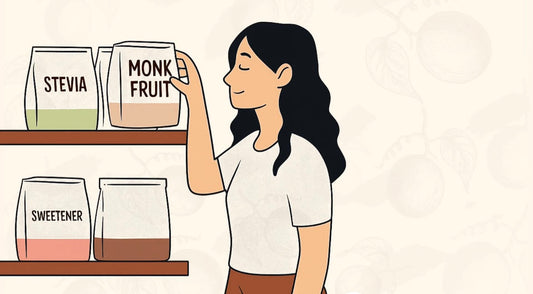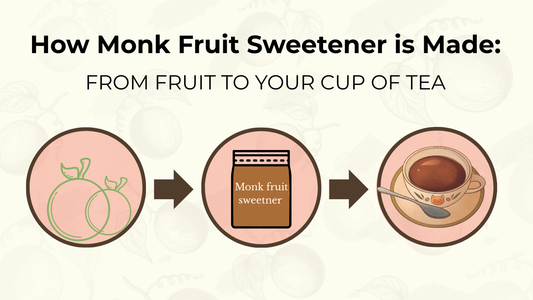Why Science Matters in Sweetness
We live in a world drowning in sugar. From chai to mithai, from soft drinks to sauces, added sugar has become so normal that most people don’t even notice how much they consume daily. But science is clear: excess sugar is one of the biggest drivers of diabetes, obesity, inflammation, and heart disease.
So what’s the alternative? Many people turn to artificial sweeteners like aspartame or sucralose - only to worry about safety, side effects, and taste. Natural options like stevia gained popularity, but the bitter aftertaste kept many people away.
And then comes monk fruit - not just another sugar alternative, but something fundamentally different. The magic lies in mogrosides - compounds that are naturally sweet yet don’t behave like sugar inside your body.
This blog is a deep dive into mogrosides: what they are, how they work, what science says about them, and why they may be one of the most exciting natural discoveries for human health.
What Exactly Are Mogrosides?
Mogrosides are a group of glycosides (a type of compound where a sugar molecule is bound to something else) found only in monk fruit (Siraitia grosvenorii).
-
Chemically, mogrosides are triterpene glycosides.
-
The sweetest and most abundant one is Mogroside V.
-
Mogrosides make up 1–2% of the dry weight of the fruit.
Unlike glucose or fructose, which the body breaks down and absorbs as energy, mogrosides are not metabolized for calories. This is why monk fruit sweetener has zero calories.
👉 Key difference: sugar = fuel, mogrosides = sweetness without fuel.
How Mogrosides Are Extracted
The process is natural and straightforward:
-
Monk fruits are harvested and crushed.
-
The juice is filtered to separate mogrosides from pulp, seeds, and water.
-
The mogrosides are concentrated into an extract.
-
This extract can be used directly or blended with erythritol for usability.
No bleaching, no refining with chemicals like sugar. Just fruit, filtered and concentrated.
Why Mogrosides Are Different From Sugar Molecules
Glucose and fructose:
-
Absorbed into the bloodstream.
-
Provide energy (calories).
-
Cause blood sugar spikes and insulin release.
Mogrosides:
-
Not absorbed as sugar.
-
Pass through the digestive system.
-
Broken down by gut microbes, then excreted.
-
No blood sugar or insulin impact.
👉 To your tongue, mogrosides taste like extreme sweetness. To your body, they’re basically invisible.
Mogrosides and Blood Sugar: What Science Says
Several studies confirm that mogrosides do not raise blood glucose or insulin levels.
-
Xu et al., 2014 (Food & Function, Royal Society of Chemistry): Found monk fruit extract did not elevate blood sugar in mice, unlike sucrose or glucose.
-
FDA GRAS Review, 2010: Concluded mogrosides are safe, non-caloric, and non-glycemic for humans.
-
Diabetic patient studies: Replacing sugar with monk fruit sweetener showed stable blood sugar control compared to sugar.
This makes monk fruit one of the safest sweeteners for diabetics.
Antioxidant and Anti-Inflammatory Properties
Mogrosides aren’t just neutral - they may actually help the body.
-
Zhou et al., 2009 (Journal of Agricultural and Food Chemistry): Mogrosides showed antioxidant activity, reducing free radical damage.
-
Liu et al., 2011 (Phytomedicine): Reported anti-inflammatory effects, including reduced markers of inflammation.
Chronic inflammation is linked to diabetes, obesity, cancer, and heart disease. Mogrosides may help calm it.
Mogrosides and Diabetes
-
Mogrosides improve insulin sensitivity in animal studies.
-
They may protect pancreatic beta cells (which produce insulin) from oxidative stress.
-
A study in Phytotherapy Research (2016) found mogrosides helped lower fasting blood glucose in diabetic mice.
While human clinical trials are limited, early evidence is promising.
Mogrosides and Obesity/Weight Management
-
Mogrosides have zero calories, making them useful for weight loss.
-
They may reduce fat accumulation by influencing gene expression related to metabolism.
-
Animal studies show reduced weight gain when sugar is replaced with monk fruit extract.
In a country like India, where obesity rates are rising, this could be a game changer.
Mogrosides and Cancer Research
-
Early studies suggest mogrosides may suppress tumor growth.
-
Li et al., 2014 (Oncology Letters): Found mogrosides inhibited growth of pancreatic cancer cells in vitro.
-
More research is needed, but this points to mogrosides as “functional compounds” with therapeutic potential.
Mogrosides and Gut Health
Unlike sugar, which disrupts the gut microbiome, mogrosides may support it:
-
They reach the colon intact.
-
Gut bacteria metabolize them into beneficial compounds.
-
This could help maintain balance in the gut ecosystem.
Healthy gut = lower inflammation, stronger immunity, better metabolism.
Safety Studies and Approval
-
FDA (USA): Monk fruit extract given GRAS (Generally Recognized As Safe) status.
-
EFSA (Europe): Approved for food use.
-
Long-term safety: No carcinogenic, reproductive, or metabolic harms detected.
Mogrosides are considered one of the safest natural sweeteners available.
Mogrosides vs Steviol Glycosides (Stevia)
|
Feature |
Mogrosides (Monk Fruit) |
Steviol Glycosides (Stevia) |
|
Source |
Fruit (monk fruit) |
Leaf (stevia) |
|
Sweetness |
100–200x sweeter than sugar |
200–300x sweeter than sugar |
|
Taste |
Clean, no bitterness |
Bitter aftertaste for many |
|
Functional effects |
Antioxidant, anti-inflammatory |
Some anti-diabetic potential |
|
Consumer acceptance |
High (closer to sugar) |
Mixed (aftertaste complaints) |
👉 Both are better than sugar, but mogrosides have the edge in taste and functional benefits.
Why Mogrosides Are More Than Just Sweeteners
Most sweeteners are just “neutral replacements” - they don’t harm, but they don’t help either.
Mogrosides are different. They are bioactive compounds:
-
Fight oxidative stress.
-
Reduce inflammation.
-
Support metabolism.
-
May protect against chronic diseases.
That makes monk fruit not just a sugar substitute, but a functional food ingredient.
The India Angle: Why This Matters More Here
-
India has the highest number of diabetics in the world (over 100 million).
-
Traditional “healthy sugars” like jaggery or honey are still high glycemic.
-
Artificial sweeteners have low trust.
-
Stevia adoption is limited due to taste.
Monk fruit, powered by mogrosides, is the natural answer India needs: clean, safe, tasty, and effective.
EPRA Farms Perspective
At EPRA Farms, we believe in education first. People need to understand not just what monk fruit is, but why it’s different.
That’s why we focus on:
-
Clean blends (monk fruit + erythritol).
-
Transparency (certifications, lab reports).
-
Accessibility (making monk fruit affordable in India).
We’re not just selling sweetener. We’re building India’s first clean-sweet movement.
Final Takeaway: Mogrosides, the Sweet Compounds That Change Everything
-
Sugar = calories + spikes + inflammation.
-
Mogrosides = sweetness + antioxidants + zero glycemic load.
-
Backed by centuries of tradition and modern science.
-
Safe, natural, diabetic-friendly, and functional.
👉 This isn’t just a new sweetener. It’s a paradigm shift in sweetness.
With monk fruit and mogrosides, sweetness finally works for your health, not against it.


